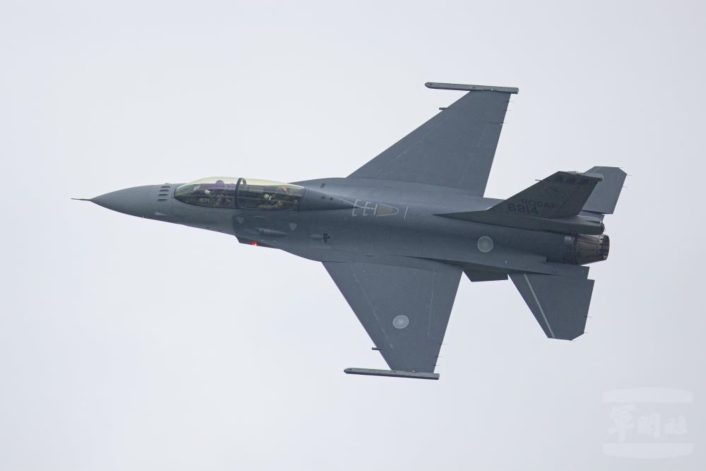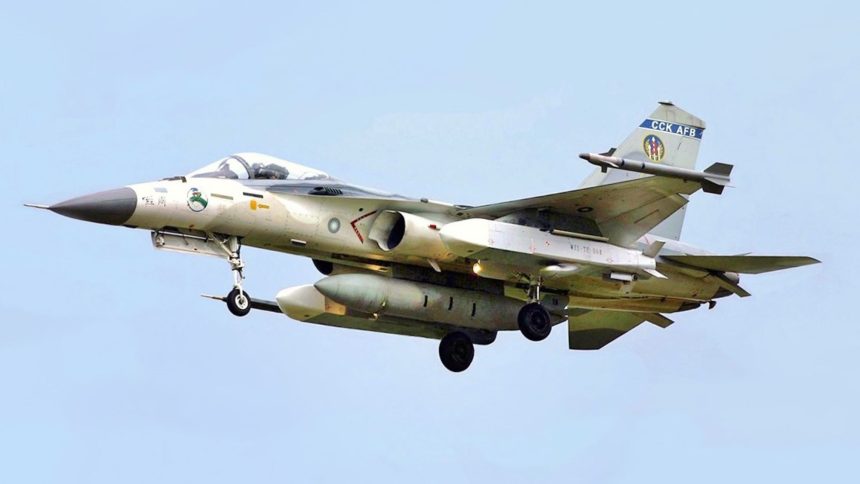Taiwan could not develop the engine and electronics for the ADF, while foreign defense firms were unwilling to participate as primary contractors. Meanwhile, the military is showing signs of shifting its focus towards “asymmetric combat capabilities.”
Taiwan might not move forward with its Advanced Defense Fighter (ADF) program over a host of technological, financial and commercial-diplomatic hurdles, Up Media reported. Chief among them is a prohibitive cost, together with the inability to develop a high-thrust engine and “unwillingness” of foreign defense firms to participate as the main contractors. The report also mentioned the thrust on “asymmetric” systems that is de-prioritizing big capital weapons, a subject that The Aviationist had previously discussed.
Within days, Liberty Times reported that the Chien Hsiang kamikaze drone has entered serial production. The radar-killing loitering munition is possibly the face of Taiwan’s ‘asymmetric warfare’, which also includes USVs (Unmanned Surface Vessels), articulated in former Chief of Defense Staff Admiral Lee Hsi-ming’s Overall Defense Concept (ODC).
The NCSIST (National Chung Shan Institute of Science and Technology) will make 48 of the loitering munitions per year, totaling nearly 200 units by 2025. The drone comes in two variants, an anti-radiation UAV and a ‘decoy’, working together to provoke and destroy ground air defense radars. It would be important to clarify that none of the recent reports on Taiwan’s drone program have actually mentioned the ODC, but the direction its weapons development program is taking unmistakably bear its mark, suggesting it is at least adopting a part of the doctrine, if not the whole.
🇹🇼 Taiwan inizia la produzione di massa dei droni kamikaze Chien Hsiang, con quasi 200 unità pronte entro il 2025. Questi droni, sviluppati da NCSIST, hanno una portata di 1.000 km e due varianti per attacco e targeting di precisione. pic.twitter.com/EYhyVo1m9G
— Osservatorio Esteri Taiwan (@taiwan_ita) October 9, 2024
‘Can’t develop major systems and no foreign partners’
Taiwan operates a mixed fleet of U.S.-made F-16V Vipers, French Mirage 2000s and its own AIDC (Aerospace Industrial Development Corporation) F-CK-1 Ching-kuo IDF (Indigenous Defense Fighter). The IDF entered service in the RoCAF (Republic of China Air Force) in 1991. Its airframe, powerplant, avionics were developed in cooperation with General Dynamics, Honeywell (then Garrett) and the erstwhile subsidiaries of BAE and Northrop Grumman.
Up Media said that a meeting between the MND (Ministry of National Defense), RoCAF and Taiwanese aerospace institutes, saw the case against the ADF being made. The meeting pointed to “billions” of research and development funds and the missing expertise to integrate and develop key systems required like high-thrust engines, AESA radars and other advanced electronics. Stealth technology and airframe design are “not a problem,” according to the reports.
Taiwan also formally approached the U.S. for purchasing General Electric F414-GE-400 engines. This was after the ‘Vega Project’ to develop Taiwan’s next-generation engine could not create a high thrust power plant. Taipei Times had previously said the ADF is a twin-engine design, requiring a thrust of 9,979 kg that can be produced by the F414s.
The pair of Honeywell/ITEC F125 turbofans in the AIDC F-CK-1 generate 8,391 kg of thrust. Thus, “Defense Minister Gu Lixiong agreed with the meeting resolution that the next generation Advanced fighter aircraft will not be self-developed, but will be purchased from the United States.”

Reluctance of foreign defense firms was another reason. “The most important combat system is integrated by American companies,” mentioned the report. “Unless a foreign manufacturer is willing to serve as the main contractor, rashly starting the development of an advanced fighter when the country (cannot) integrate advanced fighter systems will be too risky.”
‘Asymmetric systems are taking priority’
The techno-industrial and financial constraints were not the sole determining factor. The same report also claimed “surprise” on part of former President Tsai Ing-wen, because the military had presumably by then shifted its focus on “asymmetric combat capabilities.” “The next generation advanced fighter (was) not on the priority list at all,” the report added.
“The original plan to develop the Air Force’s next-generation main fighter aircraft was blocked because the development project was not in line with the current stage of actively building asymmetric combat capabilities,” said a caption under a photo showing Tsai inspecting a F-16V Block 70.
This establishes that the new emphasis on asymmetric weapons was, albeit secondary, a reason behind the program being shelved. But more telling is the duration between both the stories. The report on the commencement of Chien Hsiang’s mass production came within just four days of the one claiming the ADF’s cancellation – which as mentioned earlier, cited asymmetric drone systems as a greater priority.
🔵 Ching-kuo
Bonita foto de un AIDC F-CK-1 Ching-kuo, uno de los cazas más exóticos del planeta.
El F-CK-1 es un caza ligero de la Fuerza Aérea de Taiwán, llamado así en honor de Chiang Ching-kuo, un Presidente de la República de China (Taiwán).
Este modelo entró en servicio… https://t.co/8IA0E7RbYD pic.twitter.com/7ly98KoGTr
— Historias de aviación 🇪🇦 (@ReinaldoDMM) August 7, 2023
Taiwan doesn’t need it either
The plan also makes sense from a military-tactical standpoint, and in harmony with the current weapons technology trends in ongoing wars in Europe and West Asia. Ukraine and Russia’s cheap repurposed civilian drones for kamikaze roles have devastated the other’s tanks, armor, parked fighter aircraft and air defense systems, worth tens of millions of dollars.
The phenomenon is also prevalent in the maritime theater relevant to Taiwan. Ukraine’s USVs have sunk and damaged multiple Russian Black Sea Fleet vessels. Although they are destroyed more often than they can score a hit, USVs necessitate the use of larger and costlier platforms as countermeasure, either Su-30s and MiG-29s making strafing runs, Ka-27 naval helicopters firing their door machine guns or stub-mounted cannons and heavier missile boats using their CIWS (Close-In Weapons Systems).
U.S. and European navies’ coalition against the Houthis have famously been harrowed with the Yemeni group’s unrelenting volleys of cheap yet effective drones, anti-ship ballistic missiles and cruise missiles, causing mass crew fatigues and exhaustion. The highly skewed cost-to-benefit ratio figures here too, where platforms like F/A-18 Super Hornet or the ESSM (Evolved Sea Sparrow Missiles) shooting them down cost over roughly $60 million and $1 million respectively.
Taiwan unveiled an unmanned surface vessel (USV) inspired by Ukraine’s use of similar boats in the Black Sea.
The USV is designed to be autonomous and has a range of potential uses, including mine clearance and potentially even kamikaze attacks. pic.twitter.com/cHhVsyiWXK
— Clash Report (@clashreport) June 5, 2024
There is no reason why it shouldn’t work against the PLA Navy too. It would be even harder if the Taiwanese UAVs are autonomous free of man-in-the-loop control. As INDOPACOM (Indo-Pacific Command) chief Admiral Paparo told The Washington Post in Jun. 2024 with regards to the Hellscape program: “The U.S. military would deploy thousands of unmanned submarines, unmanned surface ships and aerial drones to flood the area and give Taiwanese, U.S. and partner forces time to mount a full response. The idea is to make their lives utterly miserable for a month, which buys me time.”
Conclusion
The ODC and asymmetric warfare has other factors going against it, the primary being a small geographical size, and thereby no strategic depth to keep the military and military industry away from the reach of Chinese missiles.
The same handicap afflicts the proposed fighter too, as the PLAAF and the PLAN would prefer destroying the bases and the jets parked there.
Meanwhile U.S. and Allied participation in the drone manufacturing effort directly draws their territories in the conflict. Even if the systems are produced, transporting them to Taipei during war would entail breaking through a Chinese air and naval blockade. This is not to mention the supply chain issues dogging Western defense industry in general. And all this is assuming U.S. and Allies would actually intervene, given the small domestic appetite for another costly war.
But nevertheless, the Chien Hsiang ‘soaring’ over the ADF marks an interesting interplay between tactics and technology. The question is what drives what – whether tactics and doctrine drive technology, or the other way round?









